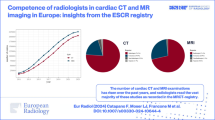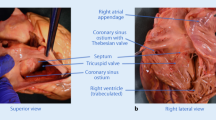Abstract
Purpose of Review
There is a broad spectrum of coronary artery anomalies that cardiologists may encounter either incidentally or during evaluation for cardiac symptoms. These anomalies include anomalous coronary arteries arising from the opposite sinus of Valsalva (ACAOS), coronary fistulae, and coronary artery aneurysms. This manuscript outlines the unique features, diagnostic characteristics, and treatment considerations for these lesions.
Recent Findings
Intravenous ultrasound (IVUS), computed tomographic angiography (CTA), and magnetic resonance imaging (MRI) are becoming more sophisticated and will be increasingly used to facilitate the optimal treatment approach for coronary anomalies.
Summary
There are a wide variety of coronary artery anomalies and their clinical ramifications range from benign to potentially fatal. Coronary anomalies often have complex anatomy and require advanced imaging modalities for comprehensive characterization. Due to the heterogeneity in lesion characteristics and outcomes, physicians should consider clinical and imaging features to create individualized management plans, along with referral to adult congenital heart disease centers.




Similar content being viewed by others
References
Papers of particular interest, published recently, have been highlighted as: •Of importance ••Of major importance
Krasuski RA, et al. Long-term outcome and impact of surgery on adults with coronary arteries originating from the opposite coronary cusp. Circulation. 2011;123(2):154–62.
Maron BJ. Sudden death in young athletes. N Engl J Med. 2003;349(11):1064–75.
Eckart RE, et al. Sudden death in young adults: a 25-year review of autopsies in military recruits. Ann Intern Med. 2004;141(11):829–34.
Taylor AJ, Rogan KM, Virmani R. Sudden cardiac death associated with isolated congenital coronary artery anomalies. J Am Coll Cardiol. 1992;20(3):640–7.
Angelini P. Coronary artery anomalies: an entity in search of an identity. Circulation. 2007;115(10):1296–305.
Warnes CA, et al. ACC/AHA 2008 Guidelines for the Management of Adults with Congenital Heart Disease: a report of the American College of Cardiology/American Heart Association Task Force on Practice Guidelines (writing committee to develop guidelines on the management of adults with congenital heart disease). Circulation. 2008;118(23):e714–833.
• Angelini P. Novel imaging of coronary artery anomalies to assess their prevalence, the causes of clinical symptoms, and the risk of sudden cardiac death. Circ Cardiovasc Imaging. 2014;7(4):747–54. This paper highlights the role of novel imaging tools such as magnetic resonance angiography, computed tomography angiography, and optical coherence tomography in diagnosing and risk stratifying patients with coronary artery anomalies
•• Van Hare GF, et al. Eligibility and disqualification recommendations for competitive athletes with cardiovascular abnormalities: task force 4: congenital heart disease: a scientific statement from the American Heart Association and American College of Cardiology. J Am Coll Cardiol. 2015;66(21):2372–84. This paper establishes guideline recommendations regarding optimal care for trained athletes with cardiac disease
Fedoruk LM, et al. Anomalous origin of the right coronary artery: right internal thoracic artery to right coronary artery bypass is not the answer. J Thorac Cardiovasc Surg. 2007;133(2):456–60.
Poynter JA, et al. Anomalous aortic origin of a coronary artery: a report from the congenital heart surgeons society registry. World J Pediatr Congenit Heart Surg. 2014a;5(1):22–30.
Poynter JA, et al. Repair of anomalous aortic origin of a coronary artery in 113 patients: a Congenital Heart Surgeons’ Society report. World J Pediatr Congenit Heart Surg. 2014b;5(4):507–14.
Frommelt PC, et al. Prospective echocardiographic diagnosis and surgical repair of anomalous origin of a coronary artery from the opposite sinus with an interarterial course. J Am Coll Cardiol. 2003;42(1):148–54.
Alegria JR, et al. Myocardial bridging. Eur Heart J. 2005;26(12):1159–68.
Mohlenkamp S, et al. Update on myocardial bridging. Circulation. 2002;106(20):2616–22.
Sorajja P, et al. Myocardial bridging in adult patients with hypertrophic cardiomyopathy. J Am Coll Cardiol. 2003;42(5):889–94.
Kiefer TL, et al. Coronary arteriovenous fistulae: the complexity of coronary artery-to-coronary sinus connections. Tex Heart Inst J. 2012;39(2):218–22.
Mangukia CV. Coronary artery fistula. Ann Thorac Surg. 2012;93(6):2084–92.
Valente AM, et al. Predictors of long-term adverse outcomes in patients with congenital coronary artery fistulae. Circ Cardiovasc Interv. 2010;3(2):134–9.
Brotherton H, Philip RK. Anomalous left coronary artery from pulmonary artery (ALCAPA) in infants: a 5-year review in a defined birth cohort. Eur J Pediatr. 2008;167(1):43–6.
Williams IA, Gersony WM, Hellenbrand WE. Anomalous right coronary artery arising from the pulmonary artery: a report of 7 cases and a review of the literature. Am Heart J. 2006;152(5):1004.e9–17.
Pahlavan PS, Niroomand F. Coronary artery aneurysm: a review. Clin Cardiol. 2006;29(10):439–43.
Aoki J, et al. Coronary artery aneurysms after drug-eluting stent implantation. JACC Cardiovasc Interv. 2008;1(1):14–21.
Satran A, et al. Increased prevalence of coronary artery aneurysms among cocaine users. Circulation. 2005;111(19):2424–9.
Demopoulos VP, et al. The natural history of aneurysmal coronary artery disease. Heart. 1997;78(2):136–41.
Newburger JW, et al. Diagnosis, treatment, and long-term management of Kawasaki disease: a statement for health professionals from the committee on rheumatic fever, endocarditis and Kawasaki disease, council on cardiovascular disease in the young, American Heart Association. Circulation. 2004;110(17):2747–71.
Swaye PS, et al. Aneurysmal coronary artery disease. Circulation. 1983;67(1):134–8.
Ruzmetov M, et al. Repair of tetralogy of Fallot with anomalous coronary arteries coursing across the obstructed right ventricular outflow tract. Pediatr Cardiol. 2005;26(5):537–42.
Gupta D, et al. Detection of coronary artery anomalies in tetralogy of Fallot using a specific angiographic protocol. Am J Cardiol. 2001;87(2):241–4. A9
Brown JW, et al. Surgical repair of congenital supravalvular aortic stenosis in children. Eur J Cardiothorac Surg. 2002;21(1):50–6.
Author information
Authors and Affiliations
Corresponding author
Ethics declarations
Conflict of Interest
Ajar Kochar and Todd Kiefer declare that they have no conflict of interest.
Human and Animal Rights and Informed Consent
This article does not contain any studies with human or animal subjects performed by any of the authors.
Additional information
This article is part of the Topical Collection on Congenital Heart Disease
Rights and permissions
About this article
Cite this article
Kochar, A., Kiefer, T. Coronary Artery Anomalies: When You Need to Worry. Curr Cardiol Rep 19, 39 (2017). https://doi.org/10.1007/s11886-017-0854-x
Published:
DOI: https://doi.org/10.1007/s11886-017-0854-x




